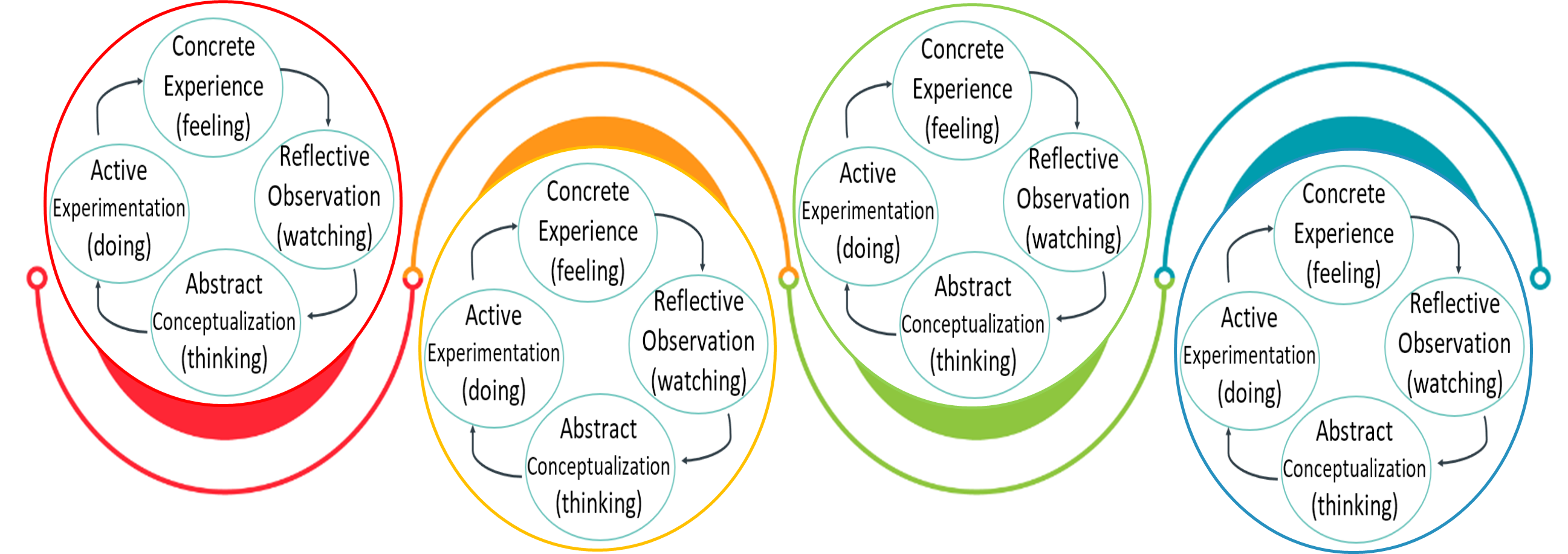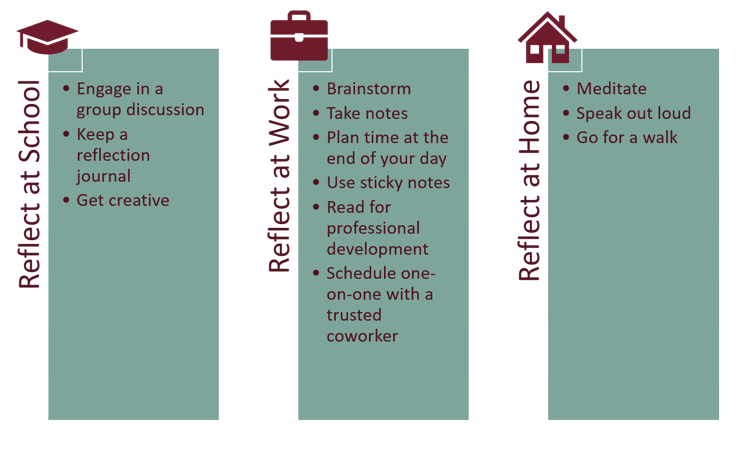Chapter 1: Work-Integrated Learning (WIL)
1.3 Reflective Practice in WIL
Reflective Practice: Combining Your Work with Your Class
Reflection is careful thinking and consideration about experiences that you have had. It can take the form of thinking, talking, or writing. The goal of reflection is to help you work through your thoughts and feelings about your experience. Reflection also helps you to remove yourself from the initial experience so that you can analyze it and see how you might do things differently next time. You can also use reflection to compare, contrast, and bring together experiences from different parts of your life. As a work integrated learning student, you are going to be constantly connecting your work life with your experience as a student in a particular discipline. As you do this more and more, it becomes a part of your regular routine. Reflective practice is when you take reflection and turn it into a regular behaviour or practice.
Reflective practice is what ties together the ‘work’ and ‘school’ parts of work integrated learning. Reflective practice during work-integrated learning encourages you to tie what you are experiencing at work to what you have learned in theory. The goal is to apply theory to practice to see how your experiences support and challenge your school learning. Reflective practice is an important component in WIL because it helps you to understand and improve on the job. Reflective practice during the work placement helps you to consider a situation and your actions and determine how well you performed or what you might do differently next time. It is an intentional process to develop a professional and continuous learning practice.
Here are some questions you can ask as you work to build your reflective practice:
- What positive experiences did you have at work today?
- What negative experiences did you have?
- What might you do differently next time?
- What did I witness today that I would like to emulate?
- What would you like to learn more about?
Continuous Reflection for Continuous Learning
Reflective practice has a lot of benefits! Students who participate in reflection have a more in-depth understanding of their learning and can take informed actions. Reflection can help you be a better student and a better worker. However, it is hard work! You need to be willing to explore your thoughts and your feelings. Sometimes, reflection can make you feel vulnerable. You may face difficulties with reflection due to fear of judgment, criticism, or feedback. You may also encounter feelings that are hard to resolve or that require you to sit with your own discomfort.
The most important thing you can do when you have trouble with reflection is to keep trying. If you feel challenged, see that as an opportunity for you to grow and develop as a professional. Seeing challenges as threats speaks to a fixed mindset and can encourage us to hold back in our efforts (Dweck, 2016, p. 31). Instead, you want to see yourself as engaged in continually growth and development. Adopting a growth mindset means seeing setbacks and challenges as opportunities to learn (Dweck, 2016, p. 34). A growth mindset is about establishing that you are capable of doing difficult things, even if you can’t yet accomplish them.
Watch the video: Growth Mindset and Fixed Mindset.
Reflection is an ongoing process in the learner’s educational and WIL journey. Earlier, we referred to David Kolb’s (1984) learning theory and linking four continual stages grounded in feeling, watching, thinking, and doing. Figure 2 shows these stages as constant and repeated with each cycle of reflection building upon the next throughout the WIL placement.

When you consistently practice reflection, it creates continuous learning and nurtures interest in your work placement journey and how to respond to changes in the workplace. Ongoing reflective practice provides huge benefits for developing and increasing awareness of self and others. It supports to develop creativity and encourages curiosity for deeper insights to inform future actions in work processes.
Driscoll Model of Reflection
As you learn to reflect, it can be helpful to use worksheets or other tools to help you. One of the most important models for reflection was created by John Driscoll in 1994. The Driscoll model incorporates the “what”, “so what”, and “now what” of the experience into your reflection (Driscoll, 1994). This means that you aren’t just describing what happened. You are taking your experience, identifying what was significant about it, and then determining what you should do next. The Driscoll model of reflection is often utilized within clinical settings; however, it can apply to various experiential learning. The model is integrated with Kolb’s learning cycle and includes trigger questions to prompt thinking through the reflection. The two processes create an experience for self-directed learning to inspect, analyze, challenge, transform, and apply behaviours towards desired outcomes.


Driscoll (1994) explains the “WHAT” of the model to recall the experience and what was felt at the time to begin the reflective cycle. “SO WHAT” analyzes the experience looking at what reactions and feelings the experience created and whether the outcome was successful or disappointing. “NOW WHAT” processes the experience and the lessons to put into context actionable ideas and behaviours to move forward with. Feel free to use the following reflective practice worksheet template as a guide. You may also be asked to use other guided reflection methods in your class.
The WIL Reflective Worksheet adapting the “what”, “so what”, and “now what”. Click to access a printable pdf version of the worksheet template: WIL Reflection Worksheet [PDF].
Ways to Reflect
Reflection can happen at work, at school, and in your personal life. Sometimes, it can be helpful to use different types of reflection to help you get a bit deeper. Here are some common ways you can reflect.

Key Takeaways
- Work-integrated learning (WIL) is career-focused experiential education that blends what you learn in the classroom with real-workplace experience.
- Experiential learning is a cycle of feeling, watching, thinking, and doing.
- There are different ways to offer WIL and nine models as determined by CEWIL.
- Reflective practice is an integral part of the student journey for self-evaluation and continual growth during WIL.
Image Descriptions
Figure 1.3 Driscoll’s “what”, “so what”, and “now what” reflection model
Driscoll’s reflection model integrated with Kolb’s learning cycle, starts from concrete experience (feeling), “WHAT?” describe the event, to reflective observation (watching), “SO WHAT?” analyze the event, to abstract conceptualization (thinking), “NOW WHAT?” proposed actions, to active experimentation (doing).
Figure 1.5 Ways to reflect at school, work, and home.
Reflect at school
- Engage in a group discussion
- Keep a reflection journal
- Get creative
Reflect at work
- Brainstorm
- Take notes
- Plan time at the end of your day
- Use sticky notes
- Read for professional development
- Schedule one-on-one with a trusted coworker
Reflect at home
- Meditate
- Speak out loud
- Go for a walk
Media Attributions
- “Growth Mindset and Fixed Mindset” by Better Than Yesterday is licensed under the Standard YouTube licence.
- “Figure 1.2 Illustration of Kolb’s learning theory paired with the cycle of reflection” by Deb Nielsen, Emily Ballantyne, Faatimah Murad and Melissa Fournier is licensed under a CC BY-NC 4.0 licence. Based on Kolb, 1984, p. 30.
- “Figure 1.3 Driscoll’s ‘what’, ‘so what’, and ‘now what’ reflection model” by Deb Nielsen, Emily Ballantyne, Faatimah Murad and Melissa Fournier is licensed under a CC BY-NC 4.0 licence. Based on Driscoll, 2017, p. 65.
- “Figure 1.4 Driscoll’s reflection model shown as an iterative process” by Deb Nielsen, Emily Ballantyne, Faatimah Murad and Melissa Fournier is licensed under a CC BY-NC 4.0 licence. Based Driscoll, 2017, p. 65.
- “Figure 1.5 Ways to reflect at school, work, and home” by Deb Nielsen, Emily Ballantyne, Faatimah Murad and Melissa Fournier is licensed under a CC BY-NC 4.0 licence.
References
CEWIL. (2021). What is WIL? Work-integrated learning (WIL) definitions. https://www.cewilcanada.ca/CEWIL/About%20Us/Work-Integrated-Learning/CEWIL/About-Us/Work-Integrated-Learning.aspx?hkey=ed772be2-00d0-46cd-a5b8-873000a18b41
Driscoll, J. (2017). Practising clinical supervision: A reflective approach for healthcare professionals. (2nd ed.). Baillière Tindall Elsevier
Dweck, C. S. (2016). Mindset: The new psychology of success. Random House
Galarneau, D., Kinack, M., & Marshall, G. (2020, May 25). Work-integrated learning during postsecondary studies, 2015 graduates. Statistics Canada. Retrieved from https://www150.statcan.gc.ca/n1/pub/75-006-x/2020001/article/00003-eng.htm
ITA. (2019). Overview. Industry Training Authority BC. https://www.itabc.ca/overview/about-ita
Kolb, D. A. (1984). Experiential learning: Experience as the source of learning and development (Vol. 1). Prentice-Hall
Merriam-Webster (n.d.). Skill. Merriam-Webster. https://www.merriam-webster.com/dictionary/skill

